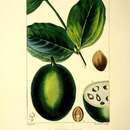Description
provided by eFloras
Lianas to 20 m. Branches grayish brown, lenticellate, glabrous; branchlets usually with 3--7 cm axillary simple tendrils. Petiole 7--10 mm; leaf blade ovate to elliptic, 6--17 X 3.5--7 cm, papery to leathery, glabrous and shiny, base obtuse to rounded, apex acute to acuminate, basal veins 3--5, reticulate veins present. Thyrses axillary, 2.5--3 cm, 10--20-flowered, minutely pubescent. Flowers fragrant, 5-merous. Calyx lobes ovate, ca. 1 mm, outside pubescent. Corolla yellowish, salverform, 1.5--1.7 cm, papillose; tube outside glabrous, inside with long woolly hairs basally, ca. 3 X as long as lobes; lobes oblong to elliptic, 4--5 mm, apex slightly thickened. Stamens inserted at corolla mouth; filaments very short; anthers oblong, 1.2--1.8 mm, glabrous, base shallowly 2-cleft, connectives apiculate at apex. Pistil ca. 1.5 cm. Ovary ovoid, ca. 1 mm. Style ca. 1.4 cm; stigma capitate. Berries orange when ripe, globose, 4--10 cm in diam.; pericarp to 5 mm thick, hard, woody, smooth, glabrous; 1--15-seeded. Seeds ovate, flat, 2--2.5 X 1.5--1.8 cm, with sericeous hairs. Fl. Apr-Jun.
- license
- cc-by-nc-sa-3.0
- copyright
- Missouri Botanical Garden, 4344 Shaw Boulevard, St. Louis, MO, 63110 USA
Distribution
provided by eFloras
Guangdong, Guangxi, Hainan, Yunnan [Indonesia, Malaysia, Philippines, Thailand, Vietnam].
- license
- cc-by-nc-sa-3.0
- copyright
- Missouri Botanical Garden, 4344 Shaw Boulevard, St. Louis, MO, 63110 USA
Habitat
provided by eFloras
Open woodlands on limestone, scrub, sometimes along river banks; 400--800 m.
- license
- cc-by-nc-sa-3.0
- copyright
- Missouri Botanical Garden, 4344 Shaw Boulevard, St. Louis, MO, 63110 USA
Synonym
provided by eFloras
Ignatia amara Linnaeus f.; Ignatiana philippinica Loureiro; Strychnos hainanensis Merrill & Chun; S. ovalifolia Wallich ex G. Don.
- license
- cc-by-nc-sa-3.0
- copyright
- Missouri Botanical Garden, 4344 Shaw Boulevard, St. Louis, MO, 63110 USA
Strychnos ignatii: Brief Summary
provided by wikipedia EN
Strychnos ignatii is a tree in the family Loganiaceae, native to the Philippines, particularly in Catbalogan and parts of China. The plant was first described by the Moravian (Czech) Jesuit working in the Philippines, brother Georg Kamel who named its seeds "the beans of St. Ignatius", in honour of the founder of his religious order.
- license
- cc-by-sa-3.0
- copyright
- Wikipedia authors and editors

